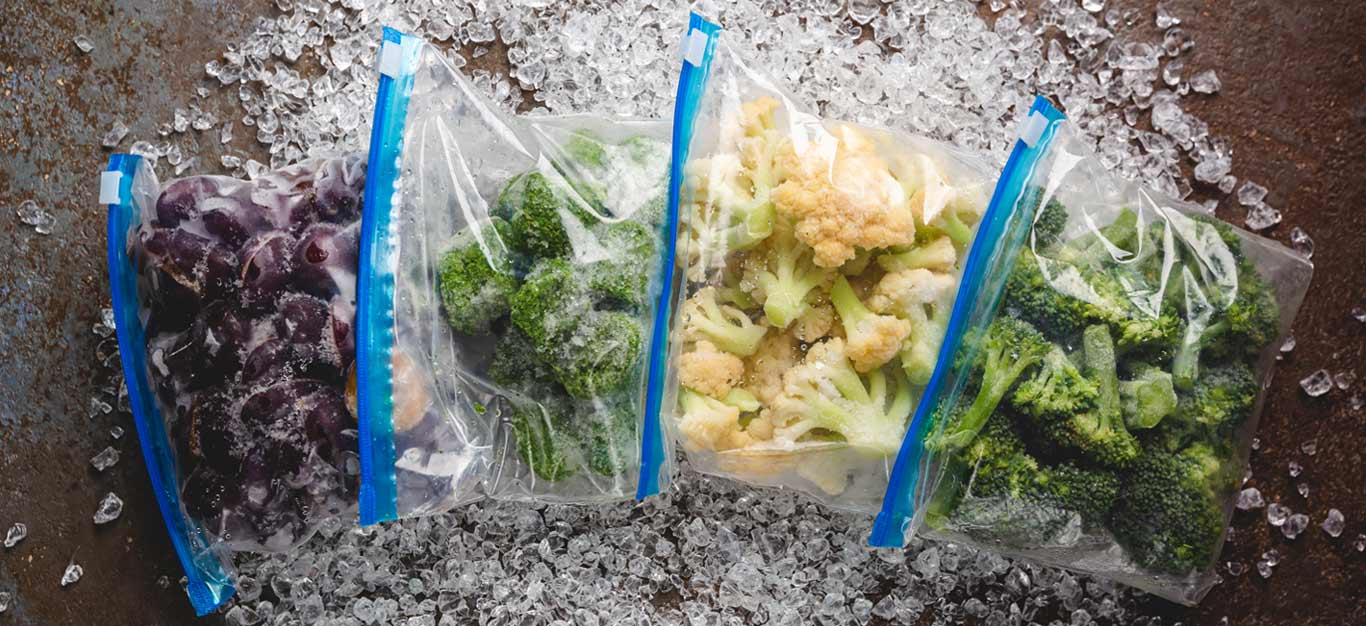How to Deal with Freezer Burn and Other Frozen-Food Pitfalls
Freezer burn is a collective term for the unpleasant changes in the appearance, taste and texture of frozen food. Read on for tips on identifying, avoiding, and rescuing foods that have suffered.
What causes freezer burn?
Toughness, shrinkage, discoloration, and ice crystal formation all fall into the freezer burn category. These changes occur as frozen food loses moisture over time and can be attributed to three main causes:
Try it for free
cooking class!
LEARN HOW TO SAUTATE WITHOUT OIL
- Bad packaging: When food is not tightly packaged or sealed in containers, cold, dry air comes into contact with food surfaces, causing dehydration. As moisture from the food evaporates and collects in the container, it turns into ice crystals on and around the food. (See below for more information on ice crystals.)
- Fluctuating temperatures: Changes in freezing temperature remove moisture from food and encourage the formation of ice crystals.
- Long storage times: Over time, air can penetrate even the tightest sealed frozen foods and cause freezer burn.
How do you prevent freezer burn?
These tips protect food from freezer burn and can extend its shelf life by several months.
- Store food in tight-fitting, moisture-proof, food-grade packaging that is durable and leakproof. Whether you choose rigid plastic or glass containers, freezer-safe resealable bags or mason jars, make sure the packaging is easy to fill, seal and label. Be sure to remove as much air as possible before freezing.
- Cool food completely before freezing to help them preserve their colour, flavor and texture. Hot food can also increase the overall freezer temperature and humidity, which can encourage ice crystal formation.
- Pack groceries in 1- or 2-cup containers which can easily be used up in a single recipe. Freeze homemade vegetable broth in 1 liter containers for use in soups and stews. You can also freeze small amounts of broth (for sautéing) and other liquids like lemon juice and aquafaba in ice cube trays (1 ice cube = 2 tbsp). Once frozen, transfer cubes to freezer-safe zip-top bags so you can use exactly what you need for a specific dish.
- Label everything with the date it went in the freezer. Green frog tape and a black sharpie work well for this task.
- Keep the freezer at least ¾ full and the temperature at or below 0˚F (-18˚C). A full freezer keeps the cold better than an empty one, reducing the risk of temperature swings. And aim to consume frozen foods within three to six months before freezer burn can occur.
- Open the freezer as seldom as possible and check gaskets on older freezers to make sure they’re still tight. Resist the temptation to use freezer door shelves for long-term storage. While they are more accessible, they are also more vulnerable to changing temperatures and humidity.
Are Freeze Burned Foods Safe to Eat?
Freezer burned foods are safe to eat as long as freezing temperatures have been maintained during storage. Even if fruits and veggies don’t look or taste as good as they did when they were first frozen, most often it’s a structural issue; These foods can be used in mixed recipes that disguise changes in texture. Beans and grains can be added to soups and stews to help fill them up and rehydrate them. (Light) Frost Coated Bread can be thawed and toasted or used to make Bruschetta or Croutons. For casseroles and other large items, after defrosting, simply cut off any dry or discolored areas and prepare as usual.
What about ice crystals?
When frozen foods are covered in snow-like crystals, it’s best to throw them. But if there are only small amounts of ice build-up, scrape it off and cook: just be prepared to adjust cooking times and/or add extra seasoning to compensate for texture changes and loss of flavor.
Help! My frozen veggies are all clumped together
Is your freezer full of clumped veggies, solid masses of beans and grains, big jugs of broth? As long as the clumping isn’t due to partial thawing, they’re perfectly safe to eat—but those large frozen blocks can be tricky to use when you only need a small portion for a recipe. If possible, break or cut off what you need and refreeze the rest. If the block is too big or too hard, thaw it completely and use any leftovers in other recipes. Refreezing makes food more susceptible to freezer burn and ice crystal formation, so it pays to freeze things in smaller 1 or 2 cup portions.
Thaw frozen foods properly
Thawing food at room temperature or in warm water is not recommended as bacteria can quickly multiply on food surfaces under these conditions. Also, rapid thawing can affect the flavor and texture of frozen foods. Especially with fruit and vegetables, rapid thawing can result in moisture being leached out rather than being reabsorbed.
For best defrosting results, place frozen food in the refrigerator a day or two before you plan to use it. Or, if you’re short on time, soak sealed containers of frozen food in cold water. Change the water every 30 minutes until the food is thawed (usually within an hour or two).
Two exceptions: if you need to quickly thaw corn kernels or peas for something like a salad, place them in a colander, run them under cold water, and use them right away.
Want to learn more basic cooking skills and become a plant-based home cook in 90 days? Check out the Forks over Knives cooking class!
